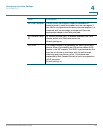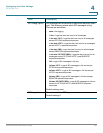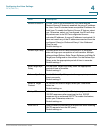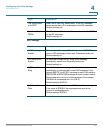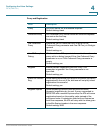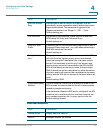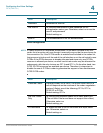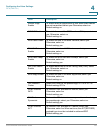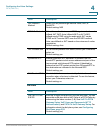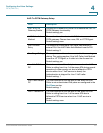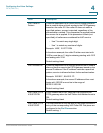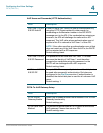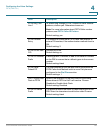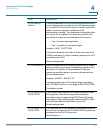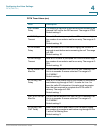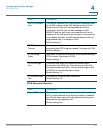
Configuring the Voice Settings
PSTN (LINE Port)
Cisco SPA232D Administration Guide 136
4
Dial Plans
FAX Passthru
Method
Select the fax passthrough method: None, NSE, or
ReINVITE.
Default setting: NSE
DTMF Tx Method Select the method to transmit DTMF signals to the far end:
InBand, AVT, INFO, Auto, InBand+INFO, or AVT+INFO.
InBand sends DTMF using the audio path. AVT sends
DTMF as AVT events. INFO uses the SIP INFO method.
Auto uses InBand or AVT based on the outcome of codec
negotiation.
Default setting: Auto
FAX Process NSE To use the fax process NSE feature, select yes. Otherwise,
select no.
Default setting: yes
Symmetric RTP Enable symmetric RTP operation. If enabled, the ATA
sends RTP packets to the source address and port of the
last received valid inbound RTP packet. If disabled (or
before the first RTP packet arrives) the ATA sends RTP to
the destination as indicated in the inbound SDP.
Default setting: yes
FAX Disable ECAN If enabled, this feature automatically disables the echo
canceller when a fax tone is detected. To use this feature,
select yes. Otherwise, select no.
Default setting: no
Field Description
Dial Plan 1/2/3/4/
5/6/7/8
Enter up to eight dial plans into this dial plan pool. You can
associate a dial plan with a VoIP Caller or a PSTN Caller by
referencing the index number (1~8). See VoIP-To-PSTN
Gateway Setup, VoIP Users and Passwords (HTTP
Authentication), and PSTN-To-VoIP Gateway Setup. For
information about the dial plan syntax, see Configuring
Dial Plans, page 225.
Default setting: (xx.)
Field Description



